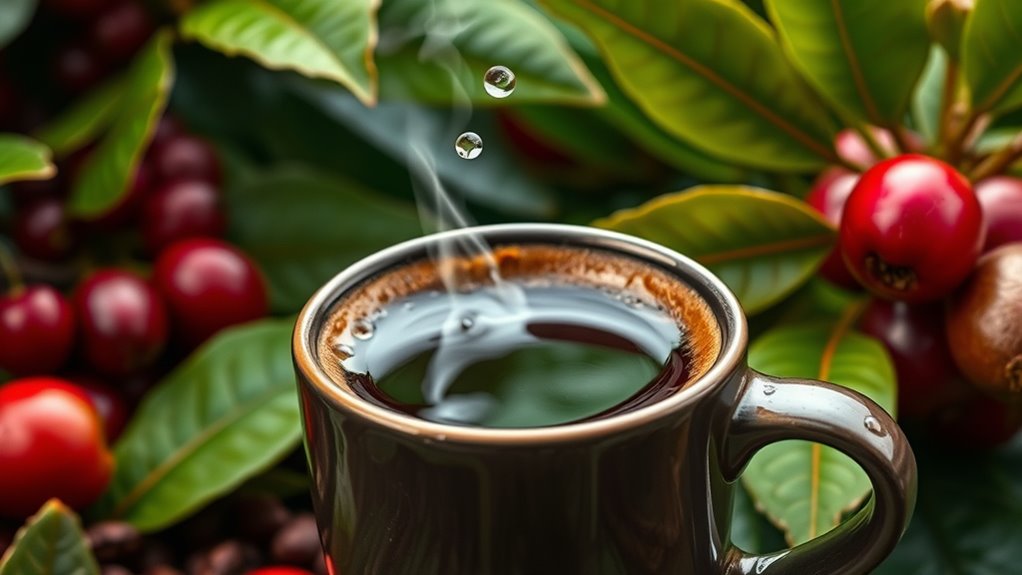Freshness is vital for experiencing the best flavors, aromas, and vibrant oils in your coffee. When coffee is fresh, it retains its complex, layered taste that quickly fades as time passes, usually within 4 to 6 weeks. Proper handling, roasting, and storage help preserve its quality longer. If you want to enjoy richer, more vibrant coffee, understanding how freshness impacts every cup is essential—stick around to discover how to maximize your beans’ potential.
Key Takeaways
- Fresh coffee retains oils and aromas, delivering a more vibrant and complex flavor profile.
- Proper handling from harvest to storage preserves freshness and prevents flavor degradation.
- Coffee’s flavor peaks within 4-6 weeks of roasting, after which it becomes flatter and less vibrant.
- Airtight, cool storage conditions slow flavor loss and maintain the coffee’s original qualities.
- Prioritizing freshness enhances the overall tasting experience, especially in high-quality and specialty brews.

Have you ever wondered why some cups of coffee taste richer and more vibrant than others? The key lies in freshness. When coffee is fresh, it retains its original, unimpaired characteristics, allowing you to experience its full flavor profile. From the moment coffee is picked, processed, dried, stored, and shipped, each step influences how fresh it remains. Proper handling during these stages is essential because it preserves the vibrant oils and aromas that define a high-quality brew.
Freshness preserves coffee’s vibrant oils and aromas, unlocking its full, complex flavor profile.
Freshly roasted beans are at their peak, offering a complex spectrum of flavors and a delightful aroma that makes each sip memorable. As time passes, however, these delicate aromas and nuanced flavors start to fade. While coffee doesn’t spoil like perishable foods, it does lose its vibrancy, becoming duller and less vibrant. That’s why specialty coffee roasters prioritize freshness—they know that it’s the best way to maintain the coffee’s complex, nuanced qualities.
The impact of freshness on flavor is significant. Fresh coffee offers intricate, layered tastes because the roasting and processing methods preserve the delicate oils and aroma compounds. When coffee ages even just a few weeks, these elements degrade, leading to a flatter, less vibrant taste. Typically, roasted coffee remains *at its peak* for about 4 to 6 weeks, though some beans can stay lively for up to two months if stored correctly.
The original flavor profile of your coffee depends on factors like the region where it was grown, the type of beans used, and how they were dried. Grinding and brewing your coffee immediately after roasting *release* those complex flavors, making the most of its freshness.
Roasting plays a pivotal role in preserving and enhancing freshness. The time and temperature at which beans are roasted directly influence their flavor and aroma. Freshly roasted beans are bursting with vibrant oils on their surface, which release strong, inviting aromas. Proper roasting not only creates distinct flavors but also *preserves* the freshness, *making sure* that the beans reach their flavor peak.
The roasting date is a critical detail—knowing it helps you gauge how fresh your coffee truly is and how long it will retain its *best* qualities.
Storage and handling are just as *important* as roasting. To keep your coffee fresh, store it in airtight containers away from air, moisture, and light—these elements accelerate flavor loss. Keep your beans in a cool, dry place, and package them immediately after roasting to *seal* in freshness during transit.
Quality control measures at every stage, from production to shipment, help *guarantee* that you receive coffee at its best. Regular tasting during the process *assures* that the beans meet freshness standards before reaching you.
Consumers recognize that freshly roasted coffee offers superior taste and quality. Marketing often emphasizes the “freshly roasted” label because it signals a better, more nuanced experience. Most coffee enthusiasts prefer fresh beans because they deliver complex, layered flavors that dull quickly with age.
Additionally, proper storage techniques are crucial because exposure to air and light significantly speeds up flavor degradation, emphasizing the importance of storage practices for maintaining freshness.
When you prioritize freshness, you’re more likely to enjoy a richer, more vibrant cup—one that truly captures the essence of the beans’ origin and craftsmanship.
Frequently Asked Questions
How Does Packaging Affect Coffee Freshness?
You should know that packaging plays a crucial role in keeping your coffee fresh. Airtight seals prevent oxygen from spoiling the flavor, while moisture barriers protect against humidity.
Opaque materials shield the coffee from light, and temperature stabilization preserves aroma.
Innovative packaging also controls degassing, maintaining the balance of flavors.
What Signs Indicate Coffee Has Lost Its Freshness?
If your coffee looks dull, smells like a forgotten basement, or tastes flat and rancid, it’s screaming that it’s lost its freshness. You’ll notice dull, dry beans, a faint or unpleasant aroma, and a flavor that’s lifeless or bitter.
Clumping grounds, mold patches, or an overly oily surface also betray stale coffee. When these signs appear, it’s time to toss that old brew and start fresh!
Can Freezing Coffee Preserve Its Freshness?
Freezing coffee can help preserve its freshness temporarily by slowing oxidation and moisture exposure.
You should store beans in airtight, opaque containers and freeze in small batches to prevent repeated thawing.
While freezing extends shelf life, it may cause some flavor and aroma loss, and once thawed, the coffee stays fresh for only 5-6 days.
Proper storage and quick usage after thawing are key to maintaining quality.
How Does Grind Size Impact Freshness?
Imagine you grind coffee in the morning for a quick brew. Your small, fine grind exposes more surface area to oxygen, causing rapid flavor and aroma loss.
Grind size directly impacts freshness—finer grinds lose their volatile compounds faster than coarser ones. So, if you prefer quick, rich flavors, grind just before brewing.
Larger grinds stay fresh longer, giving you a more consistent coffee experience over time.
What Is the Ideal Storage Temperature for Coffee?
You should store your coffee at a temperature between 15°C (59°F) and 25°C (77°F). Keeping it within this range helps preserve its flavor and aroma by slowing down degradation processes.
Avoid temperature fluctuations, as they can cause condensation and flavor loss. Maintain a consistent, cool, dark environment to make certain your coffee stays fresh longer.
Proper temperature control is key to enjoying great-tasting coffee every time.
Conclusion
If you want your coffee to taste like a glorious symphony instead of a dull drone, freshness is your secret weapon. Imagine every sip exploding with vibrant flavors so intense, they could wake the dead! Don’t settle for stale, lifeless brews that strip joy from your mornings. Keep your coffee fresh, and you’ll access a flavor experience so mind-blowingly delicious, it’ll make every day feel like a celebration. Trust me, your taste buds will thank you forever!









